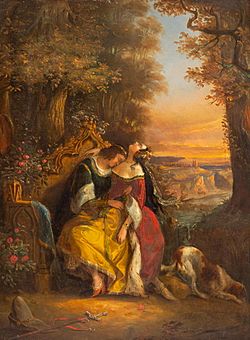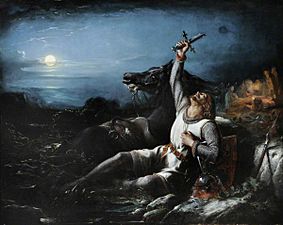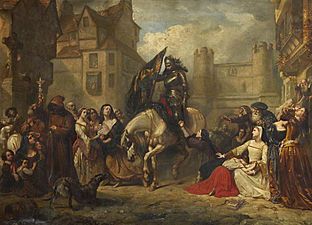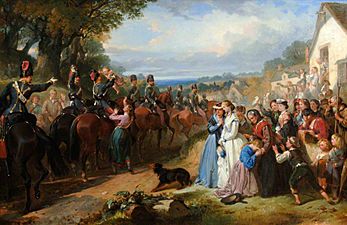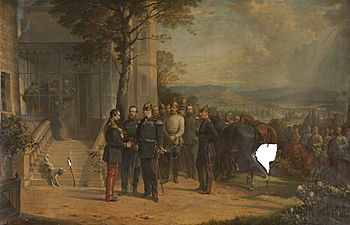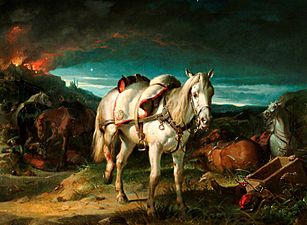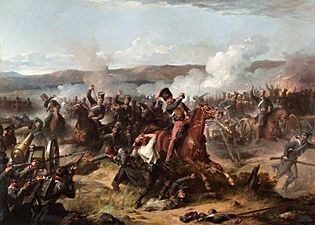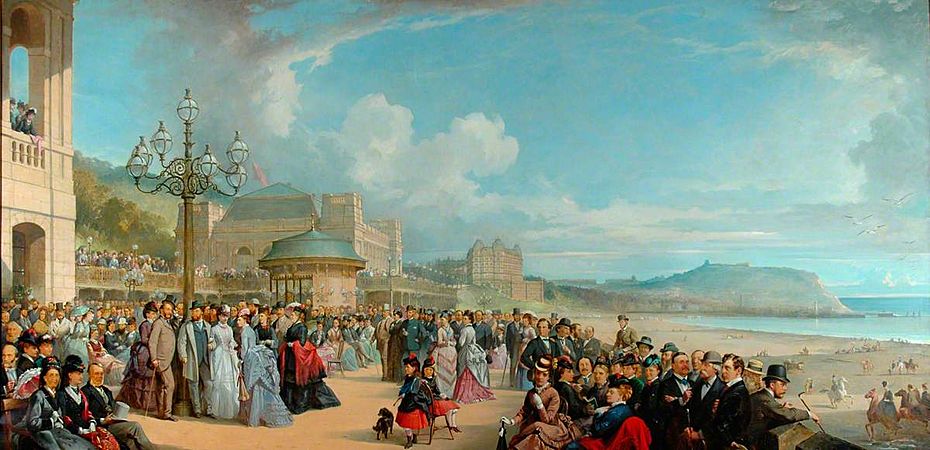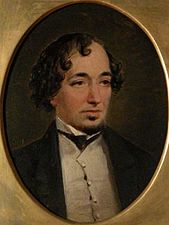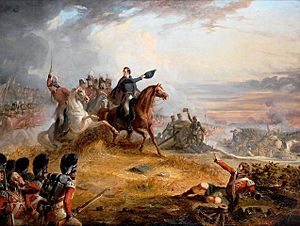Thomas Jones Barker facts for kids
Quick facts for kids
Thomas Jones Barker
|
|
|---|---|
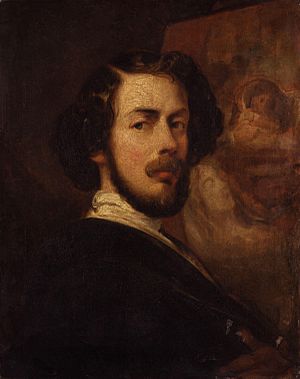
Self-Portrait, 1848
National Portrait Gallery, London |
|
| Born | 19 April 1813 |
| Died | 29 March 1882 (aged 68) Haverstock Hill, Hampstead
|
| Education | Studio of Horace Vernet |
|
Works
|
The Bride of Death (1839), Parisina (1842), The Secret of England's Greatness (c. 1862–1863), The Battle of Waterloo (undated) |
| Parents |
|
| Signature | |
Thomas Jones Barker (born April 19, 1813 – died March 29, 1882) was an English artist. He was famous for painting historical events, military scenes, and portraits of people.
Contents
Who was Thomas Jones Barker?
Thomas Jones Barker was born in Bath in 1813. He came from a family of artists. His grandfather, Benjamin Barker, painted horses. His father, Thomas Barker, was also a well-known painter, sometimes called "Barker of Bath." Thomas Jones Barker's uncles, Benjamin Barker Jr. and Joseph Barker, were also painters. His younger brother, John Joseph Barker, and his cousin, Marianne A. Barker, also painted. Art was truly a family business for them!
His Time as an Artist in France
Thomas Jones Barker started learning art from his father. In 1834, when he was 19, he moved to Paris, France. There, he studied with a famous artist named Horace Vernet.
Barker showed his paintings for the first time at the Paris Salon in 1836. The Salon was a big art exhibition. He showed three paintings and even won a bronze medal for one called Beauties of the Court of Charles II. From 1836 to 1850, Barker showed 28 paintings at this important annual exhibition in Paris.
Many of his early paintings in France showed hunters, dogs, and wild animals. He even had a dog named Mentor, who appeared in some of his artworks.
Barker's art was very popular in France. He was invited to meet King Louis Philippe I. The King even asked him to paint two special pictures. For these works, the King gave Barker a special award called the Cross of the Legion of Honour. One of these paintings, showing the death of Louis XIV, was lost during the French Revolution of 1848.
The Bride of Death Painting
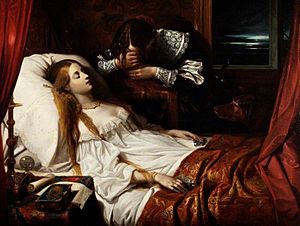
Barker's second painting for the French royal family was for Princess Marie. This painting, called La finacée de la mort (which means The Bride of Death), was finished in 1839. It was shown at the Paris Salon in 1841. Princess Marie, who was also an artist, said it was a very thoughtful and artistic painting.
A French poet named J-F. Destigny described it as a sad and moving story of love and sorrow. He felt it showed deep feelings. The painting even includes Barker's own dog, Mentor, whose eyes were said to look very real.
Today, The Bride of Death can be seen at the Victoria Art Gallery in Bath. For a long time, it was considered Barker's most famous painting. The painting was inspired by an old French poem.
Parisina Painting
Another important painting by Barker was Parisina, shown in 1842. This artwork shows how much his teacher, Horace Vernet, influenced him. It also shows the Troubadour style, which was popular then. This style liked to show idealized scenes from the Middle Ages and Renaissance.
Parisina was inspired by a long poem by Lord Byron. The poem tells a dramatic story about a love triangle. It involves an Italian nobleman named Azo, his young wife Parisina, and Azo's son, Hugo.
For many years, no one knew where Barker's Parisina painting was. But in 2020, it was found and sold at an auction in New York.
His Career in England: War Art
Barker moved back to England in 1845. From then until 1876, he showed 29 paintings at the Royal Academy. He became best known for his military paintings, showing both past and current wars. Some of his first military artworks were about the Napoleonic Wars. An example is his 1853 painting Wellington at Sorauren.
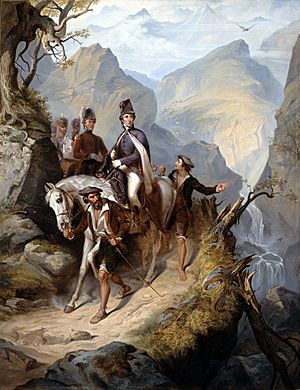
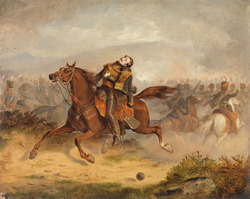
In 1870, Barker actually saw parts of the Franco-Prussian War. This included the Battle of Sedan and the surrender of Napoleon III. He also painted many scenes from the Crimean War.
One of his famous paintings is The Relief of Lucknow, 1857, finished in 1859. This painting was even shown to Queen Victoria. To make it very realistic, Barker included many real portraits of the people involved. He used sketches by a Swedish artist, Egron Lundgren, who had visited India. Barker was good at painting large scenes with many figures. When these paintings were made into prints, they often came with a key to identify all the people.
People at the time said that Barker was most famous for his paintings of modern wars. These works became very popular, especially as engravings. Many of his war paintings were very large.
Even though he was popular and successful, art critics didn't always praise him. He also never became a member of the Royal Academy. However, he was still seen as a top artist for military scenes in Britain. One writer in 1878 called him "the Horace Vernet of England," meaning he was England's best military painter.
-
The Faithful Knight, n.d., Museums Sheffield
-
News of Battle: Edinburgh after Flodden, by 1850, St Andrews Museum, Fife
-
The Relief of Lucknow, 1857, 1859, National Portrait Gallery, London
-
Departure of a Troop of 11th Hussars for India aka The Girls We Left Behind, 1866, HorsePower: The Museum of the King's Royal Hussars
-
Surrender of Napoleon III at Sedan, 1870, Blackburn Museum and Art Gallery.
-
Riderless Horse After the Battle of Sedan, c. 1870, Southampton City Art Gallery
His Career in England: Portraits
Throughout his time in England, Barker also painted portraits of people. These included famous figures like Disraeli and Garibaldi. He also painted less famous people, as long as they could pay him. Barker also created large paintings that showed many recognizable people gathered together, like The Spa Promenade from 1871.
-
Portrait of Dr. John Snow (detail), 1847, private collection
-
Portrait of Benjamin Disraeli, 1862, Hughenden Manor
-
Marie Effie (née Wilton), Lady Bancroft, c. 1870s-1882, National Portrait Gallery, London
-
Portrait of John Newton Mappin (1800-1884) 1877, Museums Sheffield
The Secret of England's Greatness
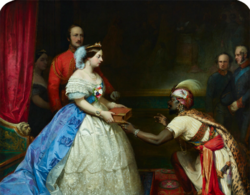
This painting, made around 1862–1863, was very popular when it was first shown. It traveled around northern England and Ulster. Later, it was mostly forgotten. But after the National Portrait Gallery bought it in 1974, it became a famous symbol of the Victorian era. It is now Barker's best-known painting.
The painting gained new interest when it was part of an exhibition called Black Victorians in 2005 and 2006. This led many art historians to study it more closely. It has become Barker's most talked-about and debated artwork.
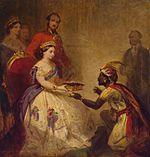
The painting's full title is Queen Victoria Presenting a Bible in the Audience Chamber at Windsor. It shows Queen Victoria giving a Bible to an African ambassador. While this specific event probably never happened, it was inspired by a story from 1859. In that story, an African ambassador visited Queen Victoria to learn the secret of England's power. The Queen supposedly told him that the Bible was "THE SECRET OF ENGLAND’S GREATNESS."
The painting shows Queen Victoria and the kneeling African figure. Some people say the way they are arranged reminds them of old religious paintings. The black figure kneeling also looks like how freed slaves were often shown in art. The painting focuses on the moment where their hands almost touch over the Bible.
This painting was also a main part of the Artist and Empire exhibition at the Tate Britain in 2015 and 2016. A toy company even made figurines based on the image.
His Final Years
Thomas Jones Barker passed away at his home in Hampstead on March 27, 1882. He was 68 years old. He was buried in a family grave at Highgate Cemetery.
His Paintings at Auction
In 2015, one of Barker's paintings set a new record for his work at an auction. His painting Battle of Waterloo sold for £50,000 in London. The auction house said that Barker's painting of Waterloo was very dramatic. It clearly showed the moment when the Duke of Wellington gave a key order during the battle. They called it a very important artistic picture of a major moment in history.
Images for kids
-
Thomas Barker (father of Thomas Jones Barker), Self-Portrait, c. 1794, Holburne Museum
-
Thomas Barker, Self-Portrait, c. 1796, No. 1 Royal Crescent, Bath
-
Thomas Barker, Self-Portrait, n.d., Victoria Art Gallery
-
Thomas Barker, Portrait of Priscilla Jones (later his wife and the mother of Thomas Jones Barker), c. 1802, Holburne Museum
-
Benjamin Barker Jr. (uncle of Thomas Jones Barker), Self-Portrait, n.d., Victoria Art Gallery
-
Benjamin Barker, Jr., Portrait of Joseph Barker (both were uncles of Thomas Jones Barker), c. 1800, Victoria Art Gallery
-
Thomas Barker, portrait of his son Thomas Jones Barker, c. 1820, Victoria Art Gallery
-
Thomas Jones Barker, Self-Portrait, n.d., Victoria Art Gallery


